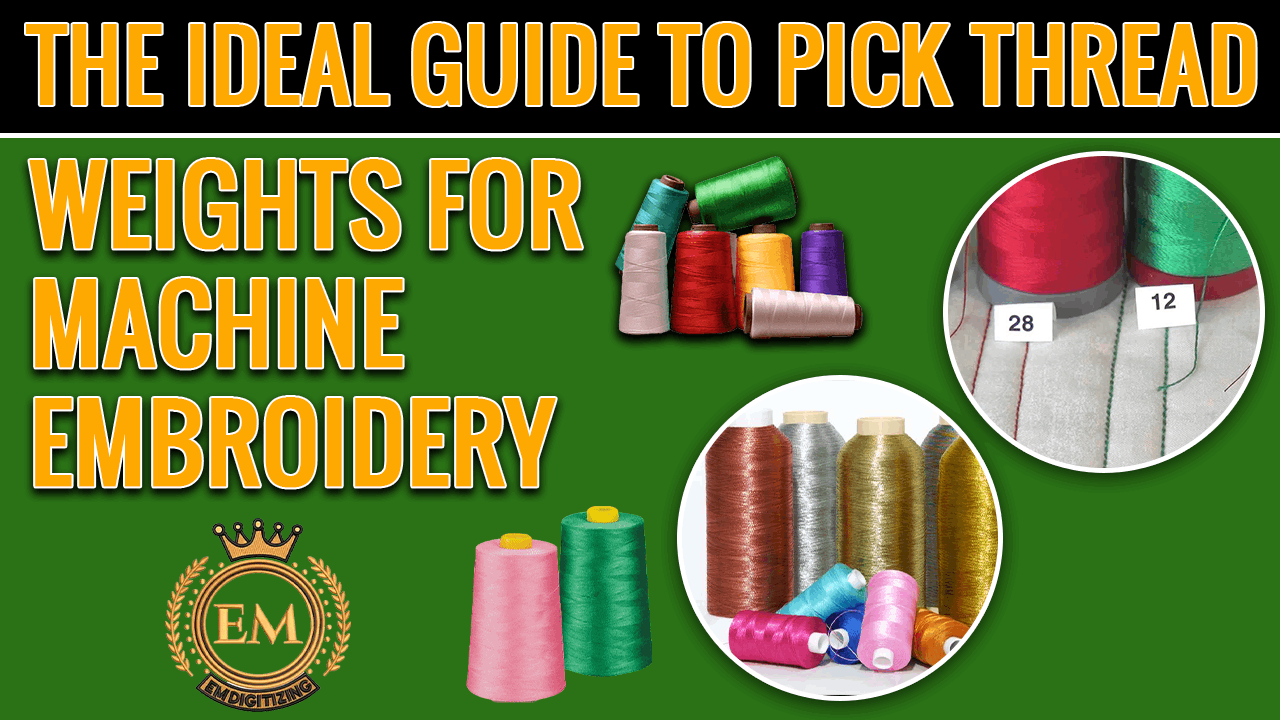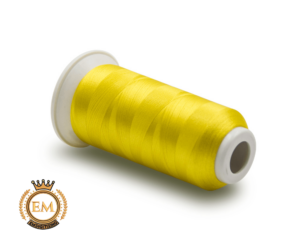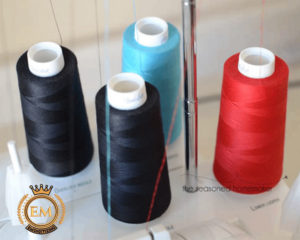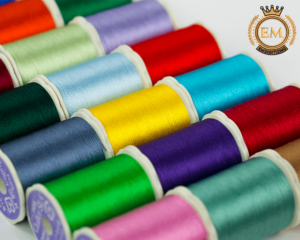Il ricamo a macchina è interessante, ma travolgente per un nuovo arrivato. I principianti tendono a ignorare l'importanza di comprendere i diversi tipi di fili per ricamo a macchina e pesi dei fili.

Servizi di digitalizzazione del ricamo
Sei qui perché vuoi saperne di più sui pesi dei fili, i loro tipi, e tutto. Bene, sei nel posto giusto! In questo articolo, copriremo il poliestere, cotone, seta, rayon, e pesi del filo per ricamo a macchina.
Prima di passare ai pesi dei fili, è importante capire che non tutti i thread sono simili, e non tutte le macchine sono uguali. Abbinare la marca del filo alla macchina e all'ago è come trovare la ricetta migliore. Pochi tipi e marche di filo funzioneranno meglio con macchine e aghi specifici.
È fondamentale testare prima il filo su un pezzo di tessuto di scarto piuttosto che sulla tua maglietta preferita. Assicurati che il tessuto su cui eseguirai la prova sia lo stesso che utilizzerai per il tuo progetto. Ordina prima una piccola quantità di filo per effettuare test adeguati e vedere cosa funziona meglio con la tua macchina e il tuo obiettivo creativo.
Fili da ricamo in poliestere:

Un filo di poliestere è resistente, Colorfast, durevole, e può anche resistere alla candeggina al cloro. Il filo di poliestere dona una lucentezza che conferisce al tuo ricamo un aspetto professionale. Questo filo è disponibile in una vasta gamma di colori ed è noto per funzionare senza intoppi.
È una scelta straordinaria per il ricamo generale, in particolare indumenti da esterno o indumenti per bambini. Sappiamo tutti che i bambini sono piccoli angeli che non disordinano, ma quando lo fanno fanno un pasticcio, il poliestere resisterà al processo di pulizia.
L'ultima cosa che una macchina desidera è un filo che si rompe costantemente. La tua macchina sarebbe felice di utilizzare filo di poliestere nei tuoi progetti. Poiché i fili di poliestere hanno la tendenza a durare a lungo e non si rompono facilmente rispetto ad altri fili, il che fa sì che la macchina funzioni in modo fluido ed efficiente. Anche se, un filo di poliestere non dovrebbe essere utilizzato per tutti i tuoi progetti.
Fili da ricamo in rayon:

Rayon ricamo a macchina i fili sono una scelta comune perché è una straordinaria selezione di colori, ancor più del poliestere. Il suo unico punto debole è la sua resistenza rispetto al poliestere. Il poliestere ha un punto di rottura molto più alto del rayon. Ecco perché è importante testare diverse marche di filati di rayon con la tua macchina per vedere come resistono con punti ad alta intensità disegni da ricamo e cuciture ad alta velocità.
Il filo di rayon funziona bene durante le cuciture ad alta velocità. È più morbido del poliestere ed è più adatto per lavori complessi o per lavori con pizzi indipendenti.
Fili da ricamo in cotone:

Dove il poliestere e il rayon sono orgogliosi del loro aspetto più brillante, il filo di cotone ha una bella lucentezza morbida. Puoi ordinare fili di cotone con finitura opaca per stimolare ulteriormente la tua creatività. Funziona bene nella maggior parte delle macchine, ma ancora una volta, è bene testarlo per assicurarsi che funzioni senza intoppi.
I fili di cotone possono essere acquistati in spessore standard, ma esistono anche varietà estremamente pregiate, adatto per lavori complessi e delicati. Ricorda sempre che più sottile è il filo, maggiore è la probabilità che si rompa durante il ricamo.
Fili da ricamo in seta:

La seta è ricca e ricercata nel settore della moda, ed è considerato altrettanto ricco quando si tratta di ricamo a macchina. Il filo di seta è forte e fine, tuttavia ha una lucentezza e una morbidezza ineguagliabili sia dal rayon che dal poliestere.
Per questi motivi, il filo di seta potrebbe essere costoso, e potrebbe essere difficile ottenere colori particolari. È il filo che vorresti utilizzare per progetti di fascia alta o per ricamare su materiali di lusso.
Fili da ricamo metallici:

I fili metallici sono famosi per rompersi durante il ricamo e questo potrebbe causare frustrazione. I fili metallici donano bellissimi colori e lucentezza che altri fili non possono imitare, ma molte nuove ricamatrici sono molto frustrate perché reinfilare la macchina può essere un processo estremamente irritante e dispendioso in termini di tempo.
Questo problema potrebbe essere risolto semplicemente apportando diverse modifiche al metodo di avvolgimento e assicurando l'uso di un ago specifico per i metalli ricamo a filo.
Sono composti da un’anima centrale che viene avvolta in metalli o lamine e poi tinta con il colore desiderato. Questi fili tendono a cadere a pezzi semplicemente, che è dove l'integrità del thread sembra fallire. Raccogliere fili metallici della massima qualità ridurrà le rotture durante il ricamo, e valgono i soldi spesi in più.
Una breve lezione sui pesi dei fili da ricamo a macchina:

Vediamo dove puoi utilizzare i pesi del filo.
Il tuo filo standard sarà spesso disponibile in un filo medio da 40wt e 50 Peso. Discussioni. Ma esiste una vasta gamma di altri filati in peso super fine 100, o anche opzioni a tre pesi super robuste.
Cuci come un professionista quando sai come il peso del filo influenza le tue cuciture. Sia che tu voglia che il filo si mimetizzi o brilli e si metta in mostra, selezionare il filo giusto farebbe la differenza nei tuoi progetti di ricamo.
Pesi del filo medi:

I pesi medi dei fili sono i tipi di fili che troverai più spesso, il più delle volte filo da 40wt e 50 Peso. Discussioni. Possono essere utilizzati per il quilting, costruzione, ricamo a macchina, Sergenti, e cucito per uso generale.
I pesi medi del filo sono realizzati con tutti i tipi di materiali, compreso il cotone, rayon, poliestere, e perfino metallico.
Questo peso del filo si fonderà o apparirà a seconda del materiale di cui è fatto il tessuto. Quindi, il cotone si fonderà più di una volontà metallica. Ma se in realtà non vuoi che il tuo thread venga visualizzato, potresti dover considerare un peso diverso.
Pesi per fili fini:

I fili di peso fine vanno da 60wt a 100wt. Questi piccoli fili sono perfetti per lavori complessi come micro quilting e ricami a macchina finemente dettagliati come ricami indipendenti o monogrammi.
Possono essere realizzati dal cotone nella parte più grande al poliestere nella parte più fine. I fili sottili si amalgamano meglio e occupano meno spazio, quindi sono perfetti per applicazioni a mano e a macchina, Riattacco di carta inglese, e micro trapuntatura.
Anche la trapuntatura densa lascerebbe le trapunte più morbide, più flessibile, e più leggero poiché il filo non occupa tanto spazio né aggiunge tanto peso.
Questo 80 Il filo in poliestere si chiama DecoBob ed è considerato il filo per riattacchi e bobina preferito. Perché è così bello, rende le cuciture più piatte e più nitide durante il riattacco. Ciò è particolarmente utile quando si tratta di ricomporre la carta di base o quando si desidera abbinare con precisione disegni e blocchi. È anche sorprendentemente forte, rendendolo una scelta affidabile per tenere insieme i tuoi progetti e trapunte.
Come un filo della bobina, è supremo. Il filo sottile può essere abbinato a qualsiasi filo superiore, compresi i fili più spessi. Riduce sorprendentemente i problemi di tensione, lascia che le tue cuciture siano più piatte e sembrino più professionali, e come bonus consente alla bobina di contenere più filo poiché il filo sottile occupa meno spazio.
Pesi di filo pesanti:

I fili pesanti differiscono da 12 – 18 peso. 12i fili in peso possono ancora passare attraverso la cruna dell'ago della macchina da cucire, quindi puoi realizzare delle cuciture fantastiche con questo filo più spesso, mentre i fili da 8wt e più pesanti non sono suggeriti come filo superiore.
Utilizzare 12wt per la trapuntatura a macchina audace, trapuntatura a mano a punto grosso, pittura su filo, ricamo a mano, trapuntatura a mano a punto grosso, cuciture decorative, e persino orlare i jeans.
Quando lo usi sulla macchina, il filo più spesso si solleverà dal materiale dandoti un sorprendente effetto strutturale.
8i fili più spessi e quelli più spessi sono quelli più comunemente usati per il ricamo a mano. Anche se sono molto spessi per passare attraverso l'ago della macchina da cucire, puoi ancora lavorare con il divano e la bobina su una macchina o usarli nei looper di una taglia-cuci. Può anche essere utilizzato per cose simili a 12wt, inoltre lavorare all'uncinetto, e lavoro a maglia.
Avvolgimento:
Questa era la fine di questo articolo. Ci auguriamo che ora tu comprenda i pesi e i tipi di filo. Ci auguriamo che ti sia piaciuto leggere questo articolo come abbiamo fatto noi per iscritto.
Se desideri personalizzare la digitalizzazione del logo del ricamo, EM DIGITALIZZAZIONE sarà la scelta migliore. Presso EM DIGITALIZZAZIONE, forniamo il miglior logo da ricamo servizi di digitalizzazione con la migliore qualità. Noi offriamo 50% di sconto su tutti i nostri servizi ai nostri potenziali clienti al loro primo ordine. Così, richiedi subito un preventivo gratuito e ci metteremo in contatto con te.
Spero che questo articolo sia utile per voi ragazzi!
Se ci sono domande relative a questo articolo, non esitare a commentarci. E, grazie per aver letto!
Pesi con 40 sono considerati il filo più fine e leggero rispetto al 60wt. Più alto è il numero, più sottile è il filo! 40Il filo wt deve essere il filo preferito per il ricamo quotidiano a tutto tondo.
sì, UN 30 il filo di peso è più spesso e più pesante di un filo di peso 50 perché è più denso e impiega solo trenta km per eguagliare un kg rispetto a 50. La frazione sulla bobina di filo indica il peso e il numero di capi o fili attorcigliati insieme.
28-i fili pesanti sono il secondo filo più pesante e sono perfetti per il punto croce a doppio filo, punto coperta, riattacco a mano, applicato a mano, trapuntatura a mano, pizzo a macchina, e cucitura ad anello inferiore.
40 i fili pesanti sono i fili da ricamo più comunemente usati e coprono la maggior parte dei progetti, dal ricamo a mano libera al quilting, digitalizzazione, alla costruzione dell'abbigliamento.
Il filo di cotone più utilizzato nel ricamo a mano è il cotone intrecciato, noto anche come filo da ricamo. Il cotone intrecciato viene fornito in matasse, e tutto il filo che esce dalla matassa è divisibile in 6 separato, fili sottili.
